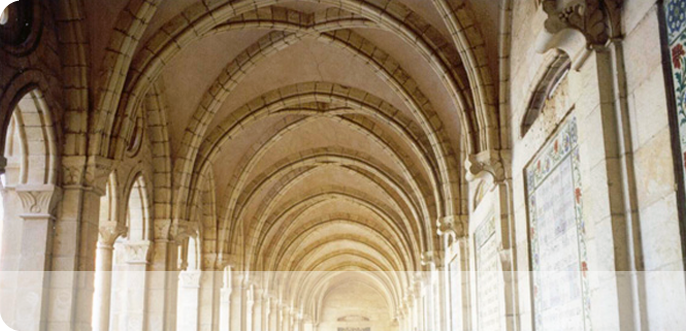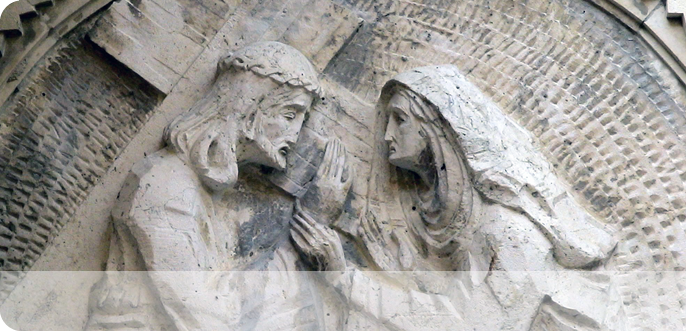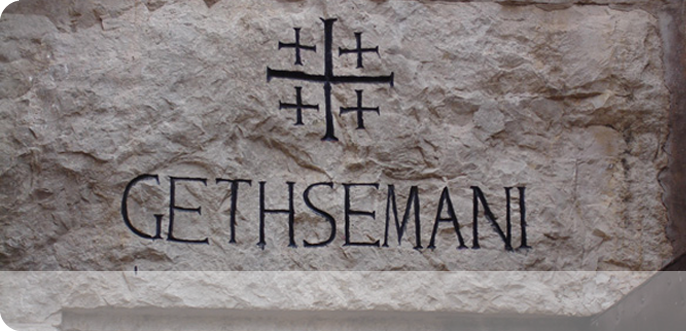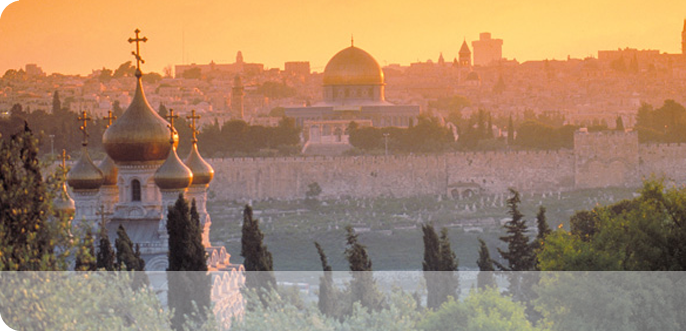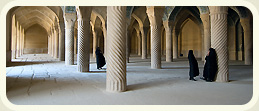Holy Land Itinerary Highlights
Sea of Galilee
The Sea of Galilee is also known as the Lake of Gennesaret, Lake Tiberias and Lake Kinneret. The Sea of Galilee is a comparatively small lake fed by the Jordan River and situated 655 feet below sea level. Storms rush down from the surrounding mountains causing rough water on the sea.
Here Jesus rebuked the winds and the sea (Mathew 8:26), taught Peter’s boat (Mark 3:79), performed the miracle of multiplication of the loaves and the fishes (Luke 5:1-11), calmed the storm (Matthew 8:23-27) and walked on water (Matthew 14:22-23, Mark 6:45). The lake’s northern shore – stretching from Mount Arbel to Hyppos – is known as the Evangelic Arch (Matthew 4:15).
The Sea of Galilee is one of Israel’s four seas and, in addition to being a repository of dozens of holy sites, is a vacation paradise for Israelis and tourists. The largest city on the lake is Tiberias, one of the four holy cities of Judaism, and the beaches and villages surrounding the lake are a haven for tourists. In addition to visiting the seaside shrines, Christian visitors can also enjoy sailing in fishing boats across the waters.
Cana
It is home to the Wedding Church, built by the Franciscans in 1879 above ruins believed to date back to Jesus’ time. Cana is where Jesus first entered public life at a wedding feast. It is here that he performed his first miracle; changing water into wine (John 2:1-11). Along side the Catholic church is the Greek Orthodox church of St. George, built in 1886. The Church of St. George houses two stone jars that Greek Orthodox followers believe to be the jars in which Jesus performed the miracle of changing water into wine.
Cana was a primarily Jewish community in the Roman-Byzantine period (1,000-2,000 years ago). In the Mameluke period (800 years ago) it was inhabited mostly by Christians and today it is predominantly Muslim. The street of the churches, in the center of the village, has been renovated and a promenade has been built, connecting the religious centers. Cana has become widely known as a place for holding weddings and renewing wedding vows. It is also a popular place for tourists to purchase wine.
The Church of the Nativity
The Church of the Nativity is an important Christian holy site as it marks the traditional place of Christ’s birth. It is also one of the oldest surviving and operating Christian churches in the world. Located in Bethlehem, the church was commissioned in 326 AD by Constantine and his mother, St. Helena and in 339 AD the Church of the Nativity was dedicated. The Constantine church was constructed with an octagonal floor plan and was placed directly above the cave believed to be the manger where Jesus was born. The original church was destroyed and rebuilt by Justinian in 530 AD. Having survived invasions by the Persians in 614 AD and the Crusaders in 1009 as well as earthquakes, lootings, occupations and neglect, it still stands today. In 1852, shared custody of the church was granted to the Roman Catholic Armenian and Greek Orthodox churches. The Church of the Nativity encompasses many significant architectural and decorative features: the Door of Humility, built to force even the most important visitor to dismount from his horse when entering; a wide nave, with 30 of the 44 columns decorated with Crusader paintings of saints and the Virgin and Child; ornate wall mosaics dating from the 1160’s and trap doors in the present floor, revealing sections of floor mosaics surviving from the original basilica. There is an Octagonal baptismal font dating back to the 6th century church of Justinian and in the Grotto of the Nativity, a rectangular cavern beneath the church, there is a silver star in the floor, marking the exact spot where Jesus is believed to have been born.
The Church of the Holy Sepulchre
The Church of the Holy Sepulchre, also known as the Church of the Resurrection to Eastern Orthodox Christians, is located in the Old City of Jerusalem and is considered to be the holiest Christian site in the world as it stands on the site where Jesus was crucified (Golgotha, or Calvary) and the tomb (sepulcher) where he was buried. The site, once destroyed by Emperor Hadrian in 66 AD to provide a level foundation for a temple to Aphrodite, Emperor Constantine the Great converted to Christianity in 312 AD and commissioned the Church of the Holy Sepulchre to be built in 326 AD. The tomb of Christ, enshrined in a small circular edifice, was not completed until 384 AD due to the tremendous labor involved in removing the rock cliff that surrounded the tomb.
The Church of the Holy Sepulchre has survived centuries of invasion, occupation, fires, damage, desecration and neglect. Many attempts were made to repair, restore and rebuild the church including undertakings by Emperor Constantine Monomachos in 1048 and the Crusaders in 1112. Today, the church is cared for by three primary custodians: the Greek Orthodox, the Armenian Apostolic and Roman Catholic churches.
Along with the exterior facade of the church, the west and east walls, the Rock of Calvary (Station 12) around which the church was built, there are many significant aspects of the church. Among these are: the edicule, the enshrined tomb of Christ; the Chapel of the Angel, with an alter containing a piece of stone rolled away by angels at the Resurrection; and the Stone of Unction, which commemorates the preparation of Jesus’ body for burial.
The Garden of Gethsemane & Mount of Olives
The Garden of Gethsemane & Mount of Olives is located, by tradition, on the lower slopes of the Mount of Olives. According to the New Testament, it was a place that Jesus and his disciples often met to pray, allowing Judas to find him on the night of his arrest. According to Luke 22:43-44, Jesus’ anguish in Gethsemane was so deep that “his sweat was as it were great drops of blood falling down to the ground”. The Garden is within the walled grounds of the Church of All Nations and is also known as the Church of the Agony. According to the Eastern Orthodox Church tradition, Gethsemane is where the Virgin Mary was buried and assumed into heaven after her dormition on Mount Zion.
Early Christian pilgrims located the Garden of Gethsemane at the foot of the Mount of Olives. Byzantine, Crusader and modern churches were built, successively, on the site where Jesus prayed just hours before his crucifixion. The modern Church of All Nations boasts a beautiful mosaic on its facade and ancient olive trees (said to be 900+ years old) still grow in the Garden.
The Mount of Beatitudes Church
The Mount of Beatitudes Church overlooks the Sea of Galilee, near Tabgha. The mount, once known as Mt. Eremos, is said to be the place where Jesus delivered his “Sermon on the Mount”. The church was built at the bottom of the hill by the Byzantines to commemorate it. Its octagonal shape represents the eight beatitudes. The lower walls are cased in marble veneer and the dome contains gold mosaic. The cool and serene gardens offer exceptional, panoramic views of the surrounding landscape.
The Sea of Galilee
The Sea of Galilee, located 655 feet below sea level, is a comparatively small, sweet-water lake fed primarily by the Jordan River. It is the lowest freshwater lake in the world and the second lowest lake on earth. It is sometimes referred to as the Lake of Gennesaret, Lake Tiberias and Lake Kinnert. The northern shore of the lake, from Mount Arbel to Hyppos, is known as the Evangelic Arch (Matthew 4:15). It is one of Israel’s four seas and it’s beaches and surrounding villages, Tiberias being the largest, are popular vacation destinations for Israelis and tourists.
The Sea of Galilee is where much of Jesus’ ministry was delivered. It is the site where Jesus rebuked the winds and the sea (Matthew 8:26), taught Peter’s boat (Mark 3:79), performed the miracle of multiplication of the loaves and the fishes (Luke 5:1-11), calmed the storm (Matthew 8:23-27) and walked on water (Matthew 14:22-23, Mark 6:45). It is also where Jesus recruited four of his disciples: Simon, the fisherman, and his brother Andrew along with brothers John and James.
The Basilica of the Annunciation
The Basilica of the Annunciation, in Nazareth, is built on a site where many other churches once existed, probably as early as the 3’rd or 4’th centuries. Among these: a Byzantine church, a Crusader church and a Franciscan church. The Franciscan church was demolished in 1955 for the construction of the present-day church which was built over the former churches’ foundations. It was consecrated in 1969 and, today, is the parish church for 7,000 Catholics in Nazareth. It is a historically significant site and, under Roman Catholic canon law, a “minor basilica”. The Basilica of the Annunciation consists of an upper and a lower church. The upper church is decorated with mosaics of the Virgin Mary and the lower church centers on the Cave of the Annunciation, where it is believed the angelic announcement to Mary took place, receiving the news from Gabriel that she would give birth to Jesus. At the top of the church is a Madonna lily-shaped dome 55 meters high, symbolizing the Virgin Mary. The earliest shrine is believed to have been built sometime in the 4’th century and was comprised of an altar in the cave where Mary lived.
About the Holy Land
A region that abounds with stories both real and mystical, the Holy Land is the place where the world’s three most popular western monotheistic religions – Christianity, Judaism and Islam – converge. With an estimated 2.1 billion Christians in the world, 1.5 billion Moslems and 1.4 million Jewish people, The Holy Land is commemorated by more than 3.6 billion people worldwide.
As the fountainhead of faith, the religious history of the Holy Land has had an immeasurable influence on global cultural formation; it’s present and future contribution as an ecclesiastical landmark continues to captivate the world.
Although a subjective term, ‘The Holy Land’ commonly refers to the area that is comprised of Israel, Palestinian territories of Gaza Strip and the West Bank, and parts of Jordan and Lebanon.
In the Jewish faith, the Holy Land is often referred to as the ‘Promised Land’ because the Hebrew Bible tells of God promising this land to the Israelites. In Islamic faith, the city of Jerusalem was the original direction of prayer and is currently the third most holy city. For Christians, the Holy Land is venerated as the original realm of Jesus Christ, the son of God.
Israel does not fail to captivate even the worldliest traveler as within this country’s borders lie many of the sacred sites that are of unmatched significance; from the town of Bethlehem where Jesus was born, to the Sea of Galilee where Jesus walked on water, to the town of Jerusalem where he was crucified and later resurrected.
Aside from these sites, Israel is also home to many important churches; The Church of the Holy Sepulchre, The Chapel of Ascencion, The Church of the Nativity, The Church of Annunciation and The Church of the Loaves and Fishes.
Though it’s widely known that the density of theologically significant sites in Israel is unmatched, few realize the significant beauty of the surrounding landscape. In particular, the city of Jerusalem is found nestled in the hills of the Judean Mountains at an elevation of roughly 2,400 feet (730 meters) above sea level. Approximately 35 miles to the west of Jerusalem is the Mediterranean Sea, and the Dead Sea lies roughly 16 miles (26 kilometers) east of the city. Israel enjoys the diversity of highly variable micro-climates; with factors such as proximity to the Mediterranean Sea and Negev Desert, and altitudinal positioning being important determinants of the local weather.
Together, Israel’s array of weather patterns, collection of distinctive religious sites, and culture of spiritual synergy offer the visitor a remarkable setting for a truly one of a kind experience. Despite their varying individual religious beliefs, people from around the world who make their pilgrimages to the Holy Land cannot help but be astounded by the ethereal beauty and ever-present spirituality in this awe-inspiring nation.



